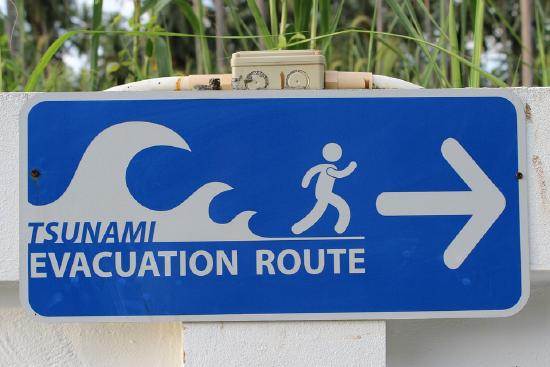2.3: How are Tsunamis Generated?
- Page ID
- 6992
\( \newcommand{\vecs}[1]{\overset { \scriptstyle \rightharpoonup} {\mathbf{#1}} } \)
\( \newcommand{\vecd}[1]{\overset{-\!-\!\rightharpoonup}{\vphantom{a}\smash {#1}}} \)
\( \newcommand{\id}{\mathrm{id}}\) \( \newcommand{\Span}{\mathrm{span}}\)
( \newcommand{\kernel}{\mathrm{null}\,}\) \( \newcommand{\range}{\mathrm{range}\,}\)
\( \newcommand{\RealPart}{\mathrm{Re}}\) \( \newcommand{\ImaginaryPart}{\mathrm{Im}}\)
\( \newcommand{\Argument}{\mathrm{Arg}}\) \( \newcommand{\norm}[1]{\| #1 \|}\)
\( \newcommand{\inner}[2]{\langle #1, #2 \rangle}\)
\( \newcommand{\Span}{\mathrm{span}}\)
\( \newcommand{\id}{\mathrm{id}}\)
\( \newcommand{\Span}{\mathrm{span}}\)
\( \newcommand{\kernel}{\mathrm{null}\,}\)
\( \newcommand{\range}{\mathrm{range}\,}\)
\( \newcommand{\RealPart}{\mathrm{Re}}\)
\( \newcommand{\ImaginaryPart}{\mathrm{Im}}\)
\( \newcommand{\Argument}{\mathrm{Arg}}\)
\( \newcommand{\norm}[1]{\| #1 \|}\)
\( \newcommand{\inner}[2]{\langle #1, #2 \rangle}\)
\( \newcommand{\Span}{\mathrm{span}}\) \( \newcommand{\AA}{\unicode[.8,0]{x212B}}\)
\( \newcommand{\vectorA}[1]{\vec{#1}} % arrow\)
\( \newcommand{\vectorAt}[1]{\vec{\text{#1}}} % arrow\)
\( \newcommand{\vectorB}[1]{\overset { \scriptstyle \rightharpoonup} {\mathbf{#1}} } \)
\( \newcommand{\vectorC}[1]{\textbf{#1}} \)
\( \newcommand{\vectorD}[1]{\overrightarrow{#1}} \)
\( \newcommand{\vectorDt}[1]{\overrightarrow{\text{#1}}} \)
\( \newcommand{\vectE}[1]{\overset{-\!-\!\rightharpoonup}{\vphantom{a}\smash{\mathbf {#1}}}} \)
\( \newcommand{\vecs}[1]{\overset { \scriptstyle \rightharpoonup} {\mathbf{#1}} } \)
\( \newcommand{\vecd}[1]{\overset{-\!-\!\rightharpoonup}{\vphantom{a}\smash {#1}}} \)
\(\newcommand{\avec}{\mathbf a}\) \(\newcommand{\bvec}{\mathbf b}\) \(\newcommand{\cvec}{\mathbf c}\) \(\newcommand{\dvec}{\mathbf d}\) \(\newcommand{\dtil}{\widetilde{\mathbf d}}\) \(\newcommand{\evec}{\mathbf e}\) \(\newcommand{\fvec}{\mathbf f}\) \(\newcommand{\nvec}{\mathbf n}\) \(\newcommand{\pvec}{\mathbf p}\) \(\newcommand{\qvec}{\mathbf q}\) \(\newcommand{\svec}{\mathbf s}\) \(\newcommand{\tvec}{\mathbf t}\) \(\newcommand{\uvec}{\mathbf u}\) \(\newcommand{\vvec}{\mathbf v}\) \(\newcommand{\wvec}{\mathbf w}\) \(\newcommand{\xvec}{\mathbf x}\) \(\newcommand{\yvec}{\mathbf y}\) \(\newcommand{\zvec}{\mathbf z}\) \(\newcommand{\rvec}{\mathbf r}\) \(\newcommand{\mvec}{\mathbf m}\) \(\newcommand{\zerovec}{\mathbf 0}\) \(\newcommand{\onevec}{\mathbf 1}\) \(\newcommand{\real}{\mathbb R}\) \(\newcommand{\twovec}[2]{\left[\begin{array}{r}#1 \\ #2 \end{array}\right]}\) \(\newcommand{\ctwovec}[2]{\left[\begin{array}{c}#1 \\ #2 \end{array}\right]}\) \(\newcommand{\threevec}[3]{\left[\begin{array}{r}#1 \\ #2 \\ #3 \end{array}\right]}\) \(\newcommand{\cthreevec}[3]{\left[\begin{array}{c}#1 \\ #2 \\ #3 \end{array}\right]}\) \(\newcommand{\fourvec}[4]{\left[\begin{array}{r}#1 \\ #2 \\ #3 \\ #4 \end{array}\right]}\) \(\newcommand{\cfourvec}[4]{\left[\begin{array}{c}#1 \\ #2 \\ #3 \\ #4 \end{array}\right]}\) \(\newcommand{\fivevec}[5]{\left[\begin{array}{r}#1 \\ #2 \\ #3 \\ #4 \\ #5 \\ \end{array}\right]}\) \(\newcommand{\cfivevec}[5]{\left[\begin{array}{c}#1 \\ #2 \\ #3 \\ #4 \\ #5 \\ \end{array}\right]}\) \(\newcommand{\mattwo}[4]{\left[\begin{array}{rr}#1 \amp #2 \\ #3 \amp #4 \\ \end{array}\right]}\) \(\newcommand{\laspan}[1]{\text{Span}\{#1\}}\) \(\newcommand{\bcal}{\cal B}\) \(\newcommand{\ccal}{\cal C}\) \(\newcommand{\scal}{\cal S}\) \(\newcommand{\wcal}{\cal W}\) \(\newcommand{\ecal}{\cal E}\) \(\newcommand{\coords}[2]{\left\{#1\right\}_{#2}}\) \(\newcommand{\gray}[1]{\color{gray}{#1}}\) \(\newcommand{\lgray}[1]{\color{lightgray}{#1}}\) \(\newcommand{\rank}{\operatorname{rank}}\) \(\newcommand{\row}{\text{Row}}\) \(\newcommand{\col}{\text{Col}}\) \(\renewcommand{\row}{\text{Row}}\) \(\newcommand{\nul}{\text{Nul}}\) \(\newcommand{\var}{\text{Var}}\) \(\newcommand{\corr}{\text{corr}}\) \(\newcommand{\len}[1]{\left|#1\right|}\) \(\newcommand{\bbar}{\overline{\bvec}}\) \(\newcommand{\bhat}{\widehat{\bvec}}\) \(\newcommand{\bperp}{\bvec^\perp}\) \(\newcommand{\xhat}{\widehat{\xvec}}\) \(\newcommand{\vhat}{\widehat{\vvec}}\) \(\newcommand{\uhat}{\widehat{\uvec}}\) \(\newcommand{\what}{\widehat{\wvec}}\) \(\newcommand{\Sighat}{\widehat{\Sigma}}\) \(\newcommand{\lt}{<}\) \(\newcommand{\gt}{>}\) \(\newcommand{\amp}{&}\) \(\definecolor{fillinmathshade}{gray}{0.9}\)If we are going to attempt to assess the risk of a tsunami at some particular place on the planet, we must first understand how to make a tsunami. Earthquakes and volcanoes generate the great majority of tsunamis, and the theory of plate tectonics explains the cause of earthquakes and volcanoes. So, we'll start with the world's briefest review of plate tectonics. Plate tectonics is the Grand Unifying Theory of geosciences, but it's actually not that old. In fact, my freshman advisor in college wrote the benchmark paper that outlined the mathematical model of plate tectonics, so in a sense, I'm only one "generation" removed from the pre-plate tectonics era. **Shameless plug alert**: For an in-depth look at the history of the theory of plate tectonics, take EARTH 520.

pixabay.com/photos/shield-characters-note-security-1768799/
The Earth's lithosphere is broken up into a bunch of discrete pieces, called plates, that move around the surface of the planet. This motion is driven by the flow of the mantle rock beneath the plates and by the forces plates exert at their boundaries where they touch each other. There are three distinct types of plate boundaries, shown illustrated by the drawing below both as separate block diagrams as well as situated within their appropriate geologic environment.
- At transform boundaries, two plates slide past each other. The San Andreas fault in California occurs at this type of plate boundary.
- At divergent boundaries, plates move away from each other. The Mid-Atlantic Ridge is a divergent boundary.
- At convergent boundaries, plates move toward each other. The Cascadia subduction zone in the US Pacific Northwest is a convergent boundary.

Earthquakes and tsunami generation
Earthquakes happen when plates move with respect to each other because the friction and stress at the edges of plates prevent them from slipping smoothly at their boundaries. For an earthquake to generate a tsunami you need:
- Water
- Vertical motion
If an earthquake happens far away from a body of water, it probably won't disturb the water too much. Therefore, no tsunami is expected. Next, you need a vertical disturbance. Picture this: You have a bathtub full of water and a hard-backed book. If you dip the book into the bathwater spine-first and move the book back and forth longways, what do you observe? Not much, except you've ruined your book. Now if you hold the book with its flat side on the surface of the water and move the book up and down in the water, you should generate some big waves as the vertical motion you've imposed on the water column is transferred to horizontal motion as the wave travels away from the source. This is basically how a tsunami is generated.
Quiz yourself!
If "The Big One" happens on the San Andreas Fault, do we expect a large tsunami? Do we expect California to "fall into the ocean" as in the cartoon I drew? Think about why or why not based on the material you just read
- Click for answer...
- We probably wouldn't expect a big tsunami. Remember the three types of plate boundaries. Earthquakes at transform boundaries, like the San Andreas fault, involve hardly any vertical motion. Divergent boundaries have some, but not tons of vertical motion. Convergent boundaries are the big culprits. When one plate is forced to dive beneath another plate, there is no way to do it except with some component of vertical motion. The cartoon below shows how an earthquake at a convergent boundary (subduction zone) creates a tsunami.

- Figure 2.3 - How a Tsunami is Created
- Click for a text description of How a Tsunami is Created.
- 1. OVERALL, a tectonic plate descends, or "subducts," beneath an adjoining plate. But it does so in a stick-slip fashion. 2. BETWEEN EARTHQUAKES the plates slide freely at great depth, where hot and ductile. But at shallow depth, where cool and brittle, they stick together. Slowly squeezed, the overriding plate thickens.3. DURING AN EARTHQUAKE the leading edge of the overriding plate breaks free, springing seaward and upward. Behind, the plate stretches; its surface falls. The vertical displacements set off a tsunami.


